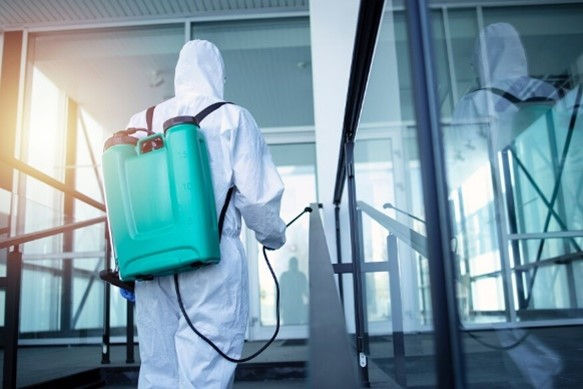How is Monkeypox Behaving in the Built Environment?
- ignacio gonzalez

- Sep 9, 2022
- 4 min read
By BLAINE BROWNELL originally posted on Architect Newswire
MIND & MATTER
Virus transmission depends on interactions between surfaces and environmental factors, Blaine Brownell finds in initial research, a design concern that invites a closer collaboration between architects, designers, and mechanical engineers to mitigate the spread of disease.

A closeup of the monkeypox virus
Soon after the COVID-19 pandemic became a significant public health threat, scientists investigated the virus’ interaction with various material surfaces to better understand its means of transmission. A notable study by the National Institutes of Health determined that the SARS-CoV-2 virus remains viable for two to three days on nonporous surfaces like stainless steel or plastic—but only 24 hours on porous materials like cardboard. Although further research later determined that COVID-19 is much more effectively spread via aerosol transmission, surface interaction remains an important research focus—particularly for pathogens spread via physical contact.
Monkeypox is one such disease. Recently declared a public health emergency in the U.S. by the Biden administration, the monkeypox virus (MPV) has spread to at least 75 countries and infected over 28,000 individuals in a few months. Until now, monkeypox was considered a rare illness, initially discovered among primate populations in 1958 and first recorded in a human host in 1970. (Although the disease gets its name from monkeys, the origin is unknown.) MPV is in the same Orthopoxvirus genus as variola, the virus responsible for smallpox, and causes similar but milder symptoms. According to the Centers for Disease Control and Prevention, MPV is transmitted through physical contact, including “touching objects, fabrics (clothing, bedding, or towels), and surfaces that have been used by someone with monkeypox.”
Vaccinia lasts much longer on glass than on industrial carpet at room temperature and low relative humidity, but the opposite effect occurs in a low-temperature, high-relative-humidity environment.
In 2013, researchers at the Battelle Memorial Institute in Columbus, Ohio, investigated the persistence of the variola virus on different materials. The scientists employed samples of the vaccinia virus (“an established surrogate” of variola) which, although not MPV, serve as a reference for how the monkeypox virus might behave in similar circumstances. The team studied four material surface types—glass, galvanized steel, painted concrete block, and industrial carpet—as well as the two environmental variables of temperature and relative humidity. The researchers recovered the following quantities of viable vaccinia virus from the four surfaces: 63% from glass, 41% from galvanized steel, 69% from painted concrete block, and 16% from industrial carpet. This outcome bears a resemblance to the relative performance of SARS-CoV-2 on nonporous and porous materials.

Notably, temperature and relative humidity proved to have a more significant influence than material type alone. Vaccinia persists longest in cool and dry environments, and in the study, samples survived in such circumstances on all materials beyond 56 days. However, when scientists changed these variables, they found that virus persistence varied based on material. For example, vaccinia lasts much longer on glass than on industrial carpet at room temperature and low relative humidity, but the opposite effect occurs in a low-temperature, high-relative-humidity environment.
In June 2022, scientists at the University Medical Center Hamburg-Eppendorf in Hamburg, Germany, studied the surface interaction of the monkeypox virus in hospital rooms. The researchers investigated two patient rooms in detail, finding that the most significant viral load existed on surfaces that encountered the most direct and frequent patient interaction. Unsurprisingly, the highest levels of viral copies per area were found on high-touch elements like bathroom door handles, cabinet door handles, chair seats, sink handles, and toilet seats. Mattress covers, patient shirts, and PPE also exhibited high quantities of the virus. However, this study did not evaluate viral persistence over a long duration, nor did it include environmental factors such as temperature and relative humidity.
Perhaps the most important question concerns the level of infectious dose required to transmit the virus, which remains unknown.
Despite the insights offered by these studies, much remains uncertain. Perhaps the most important question concerns the level of infectious dose required to transmit the virus, which remains unknown—although it is believed that a much higher quantity of MPV than variola is necessary to be contagious. Reports of individuals becoming infected with MPV from surfaces rather than direct contact with hosts are relatively rare. (The German study does mention a UK-based healthcare employee who became infected from contaminated bed linens.) That said, because surface viability is a known factor, the CDC promotes a regular cleaning regimen that includes the use of an EPA-registered disinfectant on surfaces and frequent laundering of fabrics; antimicrobial UV light can also be effective.
As the vaccinia investigation demonstrates, many factors affect pathogen viability in physical environments. Surface properties influence viral persistence significantly, and more studies are required to inform material decisions—particularly in healthcare environments. However, materials are not the only concern. Instead, the interactions between surfaces and environmental factors such as temperature and relative humidity appear to matter most when considering the presence of pathogens in spaces. Considering these interactions, we can see that virus transmission is a design concern that includes both material and immaterial factors, thus inviting a closer collaboration between architects, designers, and mechanical engineers to mitigate the spread of disease.
The views and conclusions from this author are not necessarily those of ARCHITECT Magazine, of The American Institute of Architects or of GT/AD Studio.
This article written by Blaine Brownell originally publicly posted on Architect Magazine (Architect Newswire) on August 26, 2022.




Comments